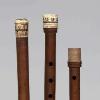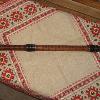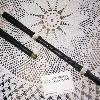

Topics: Entertainment Tags: Kaval View |
Kaval. Provided by the Library of congress Tags: Kaval View |
Български триставен Кавал в До строй, изработен от Дрян през 2009 Tags: Kaval View |
|||||||||
Tags: Kaval View |
Tags: Kaval View |
"Kaval" is also the ring name of professional wrestler Brandon Silvestry.
The kaval (pronounced IPA-xxka?val) is a chromatic end-blown flute traditionally played throughout Azerbaijan, Turkey, Bulgaria, Macedonia (Republic of Macedonia), southern Serbia (?????), northern Greece (?????? or dzhamara), Romania (caval), and Armenia (????? or blul).
The kaval is primarily associated with mountain shepherds throughout the Balkans and Anatolia and in the book Kaval: Traditional Folk Melodies for Balkan & Anatolian Folk Flute, author Pat MacSwyney suggest that the kaval spread with the Yoruks from the Taurus mountains of southern Turkey into the southern Balkans of southeast Europe.
Unlike the transverse flute, the kaval is fully open at both ends, and is played by blowing on the sharpened edge of one end. The kaval has 8 playing holes (7 in front and 1 in the back for the thumb) and usually 4 more near the bottom of the kaval. These holes are not used for playing the instrument, but determine the lowest tones pitch and timbre and are supposed to improve tone (Timbre) and intonation. In Bulgaria they are known as "devils holes", based on a folk tale in which the devil tries to out-play a shepherd in a musical duel. While the shepherd is sleeping, the devil drilled holes in the shepherds kaval but instead of ruining the kaval, this only served to enhance the shepherds kaval playing thus thwarting the devil. In Macedonia they are known as "glasnici" (????????) meaning "giving voice to/of".
While typically made of wood (cornel cherry (European Cornel), apricot, plum, boxwood (boxwood (genus)), mountain ash, etc.), kavals are also made from water buffalo horn (horn (anatomy)), Arundo donax Linnaeus 1753 (Persian Reed), metal and plastic.
When played, the kaval is held with both hands at an angle of approximately 45� from the body, with the four fingers of the one hand covering the lower holes; the upper three holes and the thumbhole are covered with the other hand. The mouth covers ~� of the end. Change of the breath air pressure also changes the pitch.
A kaval made without joints is usually mounted on a wooden holder, which protects it from warping and helps keep the interior walls oiled.
According to the key, the kaval can be in the high register (C, C#), middle (D, H) or low (A, B).
The kaval plays two octaves and a fifth, in the chromatic scale. Its sound is warm, melancholic and pleasant.
While in the past it was almost entirely a shepherds instrument (musical instrument), today it is widely used in folk songs and dances as part of ensembles or solo.
The kaval is sometimes used in pairs. The first leads and the second drone (drone (music))s, with a kaval in the same key, usually a lower one, like C, C#, D, although other keys are also in use.
Wooden rim-blown flute of south-eastern Europe and Turkey, similar to the Ney of the Arab world. Kaval may once have referred to various Balkan duct and rim-blown flutes, accounting for the present day diversity of the term?s usage. It is generally made of boxwood, with seven finger-holes and one thumb-hole, and is primarily a pastoral instrument.
The Bulgarian kaval, once made of a single piece of wood, is now constructed of three separate sections (of cornel, plum or boxwood), with a total length of 60 to 90 cm. Bone rings cover the joints, to prevent the wood from cracking. Metal decoration is also found. The finger-holes are located in the central section, while the lower (shorter) section has four additional holes called du?nici or ?avolski dupki (?devil?s holes?); these are not covered in performance. The kaval can be made in various tunings, D being the most common. Its range is almost three octaves, mostly chromatic.
In the south-west Rhodope mountains, two kavals in the same tuning (called �ifte kavali) are played together, one performing the melody, the other a drone. This type of kaval is made from one piece of wood. A similar use of the kaval is also known in Macedonia (Macedonia (region)) and Kosovo, where one kaval of the pair is ?male?, the other ?female?. The Albanian (Albanians) kavall is better known as the fyell.
In Turkey the term ?kaval? is used generally to refer to all shepherd?s pipes and more particularly (though not invariably) to ductless flutes. The presence or absence of a duct is sometimes specified by the addition of a qualification: dilsiz kaval (?kaval without a tongue?), dilli kaval (?kaval with a tongue?). Other qualifications may be added to describe materials, size or constructional features: kami? kaval? (?reed kaval?), �am kaval? (?pine kaval?), maden? kaval? (?metal kaval?); cura kaval? (?small kaval?), �oban kaval? (?shepherd?s kaval?, i.e. long kaval); �� par�al? kaval? (?kaval with three parts?). The kaval can be made of wood, cane, bone or metal (usually brass) and has five or more finger-holes, one thumb-hole and sometimes additional unfingered holes like the Bulgarian instrument.
In Thrace and some of the Aegean islands the term ?kavali? refers to an end-blown flute of the flogera family. It has seven finger-holes and sometimes an additional thumb-hole. In northern Greece the term kavali is also used to denote the souravli. In Epirus the end-blown kaval is known as dzhamara.
The Romanian caval is a large duct flute. It has five finger-holes arranged in groups of two and three, counting from the distal end. Also from Romania, the caval dobrogean (?Dobrujan caval?) or caval bulg?resc is a similar instrument to the Bulgarian kaval.
Color1: #FFD700
Color2: #FFEC8B
Image Capt: Bulgarian kaval in "C" (??) made in 2009 from European Cornel (''Cornus mas'') "????"
Classification: Woodwind, Wind (Wind instrument), Aerophone
Related: Ney, Duduk, Flute, Jedinka, Dilli Kaval, Shvi, Frula





